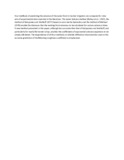| dc.contributor.author | Katyal, AK | |
| dc.contributor.author | Kijne, JW | |
| dc.date.accessioned | 2015-07-29T15:32:49Z | |
| dc.date.available | 2015-07-29T15:32:49Z | |
| dc.date.issued | 1980 | |
| dc.identifier.citation | Irrigation Science 1980 Vol. 1 No. 3 pp. 177-184 | en_US |
| dc.identifier.uri | http://www.cabdirect.org/abstracts/19801954322.html?resultNumber=4&q=au%3A%22Katyal%2C+A.+K.%22 | |
| dc.identifier.uri | http://hdl.handle.net/11295/89201 | |
| dc.description.abstract | Four methods of predicting the advance of the water front in border irrigation are compared for nine sets of experimental data reported in the literature. The water balance method (Bishop et al., 1967), the method of Katopodes and Strelkoff (1977) based on zero inertia hydraulics and the method of Michael (1978) enable the distances that the wetting front advances to be calculated for various advance times. A new method presented in this paper, although less accurate than that of Katopodes and Strelkoff, and particularly for nearly flat border strips, enables the coefficients of exponential advance equations to be simply calculated. The dependence of all four methods on reliable infiltration characteristics and on the accurate prediction of the Manning roughness coefficient is emphasized. | en_US |
| dc.language.iso | en | en_US |
| dc.publisher | University of Nairobi | en_US |
| dc.title | Prediction of the advancing wetting front in border strip irrigation | en_US |
| dc.type | Article | en_US |
| dc.type.material | en | en_US |

